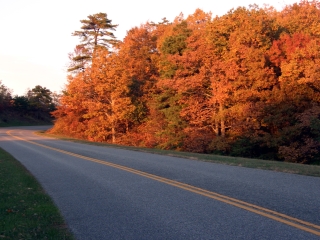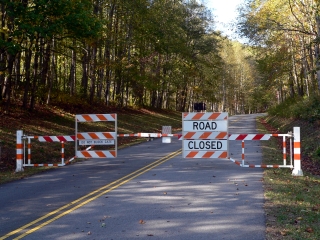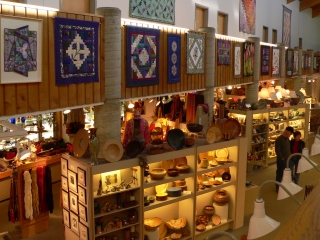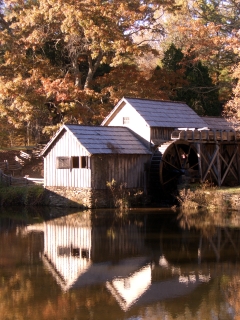Blue Ridge Parkway
stretches from Shenandoah NP, Va. to Great Smoky Mountains NP, Tenn.
Visited: October 30, 2005
NPS Site Visited: 276 of 353
NPS Website; Local Website
WHAT IS IT?
469 miles of two-lane road that follows the Appalachian Mountain ridgeline, each mile more breathtaking than the last.
 BEAUTY (10/10) BEAUTY (10/10)
The Parkway rides the long, bumpy spine of the Appalachians, roller-coastering its way above the fray and the madness below. Its humble two-lane, 45-mph speed limited road is free from billboards, litter, cross traffic and tractor-trailers. The Parkway is almost 500 miles of panoramas, sweeping vistas and majestic overlooks.
HISTORIC SIGNIFICANCE (4/10)
The Blue Ridge Parkway bisects the mountainous areas of Virginia and North Carolina known as southern Appalachia, where coal and logging industries introduced a diverse group of workers to the region previously inhabited (and probably named) by Native Americans.
Appalachian history is highlighted in many of the Parkway’s roadside stops, exhibits and remnants of farms and mills. Appalachian culture is alive in the folk art centers and music center that lie within NPS boundaries.
CROWDS (8/10)
Every Visitor Center was full. Pullouts were packed. An unseasonably warm day brought sunbathers from (we are assuming) Appalachian State University to the lawns around Moses Cone Manor. We were part of a sea of people moving along the previously inaccessible Blue Ridge in either direction.
The accessibility of the Parkway guarantees at least 20 million visitors a year. 20 million people driving just to drive, drawn by the beauty of the Blue Ridge Mountains. We felt a connection with our fellow travelers. The Blue Ridge Parkway is an essential American experience.
EASE OF USE/ACCESS (4/5)
Nine out of twelve months this rating would be a five, but icy conditions intensify at the higher altitude passes in the winter and late fall. Plan on a few road closures and detours if you visit the Parkway between the end of October and spring thaw. We encountered two.
The rest of the year, the Parkway is the easiest way to explore the Appalachian hills and ridges. The Parkway stretches from Rockfish Gap, Va. to the Cherokee Indian Reservation in North Carolina. Mile markers increase in number from North to South. Should you find yourself missing life in the fast lane, Interstate 81 parallels the east side of the Blue Ridge and the Parkway.
 The Parkway did not connect from end to end until less than 20 years ago. 461.5 of its miles were ready by 1967, but a 7.5-mile boulder-filled course over Grandfather Mountain in North Carolina was impassable until the construction of the Linn Cove Viaduct in September of 1987. Site literature calls the Viaduct, "the most complicated concrete bridge ever built." The Parkway did not connect from end to end until less than 20 years ago. 461.5 of its miles were ready by 1967, but a 7.5-mile boulder-filled course over Grandfather Mountain in North Carolina was impassable until the construction of the Linn Cove Viaduct in September of 1987. Site literature calls the Viaduct, "the most complicated concrete bridge ever built."
Asheville, N.C. and Roanoke, Va. are the largest cities close to the Parkway; the smaller towns of Lexington and Lynchburg are also easily reached. We know because we spent nights in each of them.
CONCESSIONS/BOOKSTORE (5/5)
There are not one but two opportunities to lose yourself among the rich crafts of the Southern Highland Craft Guild along the Parkway. The Parkway Craft Center is housed inside the stately Moses Cone Manor at milepost 294. The Allanstand Craft Shop, the Guild’s flagship and oldest continuously operating craft shop in the nation, occupies the first floor of the Blue Ridge Parkway’s Folk Art Center at milepost 382, east of Asheville, NC.
 So if you are kicking yourself for not picking up that piece of glassware, patchwork quilt or hand-carved puzzle box when you first saw it, odds are you can find something similar further along in your journey. The Moses Cone Manor should be awakening any day now from its winter dormancy. The Allanstand is open and active with events and demonstrations year round. So if you are kicking yourself for not picking up that piece of glassware, patchwork quilt or hand-carved puzzle box when you first saw it, odds are you can find something similar further along in your journey. The Moses Cone Manor should be awakening any day now from its winter dormancy. The Allanstand is open and active with events and demonstrations year round.
COSTS (4/5)
There is no toll for the East’s most famous drive but we dare you not to buy souvenirs at the Park’s extraordinary folk art centers.
RANGER/GUIDE TO TOURIST RATIO (4/5)
Rangers were on hand at every Visitor Center, but most were occupied with rerouting visitors around the two road closures on the Parkway. As we lined up to let the Ranger highlight our map and tell us how to get back on course, we wondered how many times she had gone through this routine already today and if perhaps there were a better way to disseminate this information.
TOURS/CLASSES (8/10)
The works of the Southern Highland Craft Guild rival any museum of American folk art that we have seen. The Folk Art Center at milepost 382 gives credence to our statement with its second floor gallery, showcasing both current artisans and works from the past while it explains the raw materials and process by which each object was made.
The brand new Blue Ridge Music Center at milepost 213 is filled with sunshine, smells of freshly hammered timber and gold records acquired by some of the forefathers (and mothers) of bluegrass and the blues. The bright and spacious main building tells of Appalachia’s contributions to American music and hosts concerts and open jam sessions in spring, summer and fall.
Mount Mitchell State Park, just off the Parkway’s milepost 355 offers more educational opportunities and exhibits, but its concrete observation deck with panoramic views of the surrounding mountains is why we strayed from the Parkway. Mount Mitchell is the highest point in the United States east of the Rocky Mountains.
 FUN (10/10) FUN (10/10)
One would think that after being in the car together for almost two years, we would not seek out roads that necessitate low speeds and prolong our drive time. We enjoyed every minute of our time on and along the Blue Ridge Parkway. Every time Gab started to fidget, a sign for the next Visitor Center appeared or a stunning overlook emerged from around a bend. Perfect timing.
We chose the trails around Linville Falls (milepost 316) as one of the sites to stretch our legs, as did everyone else it seemed. Trails were crowded but well kept. The 45-mph Parkway speed limit must have rubbed off on us. We were so relaxed and unhurried that we didn’t really mind waiting as a family scooted their throng of little ones up steps and closer to the falls. Driving the Parkway is all about going with the flow.
We were nervous about hitting the Parkway at such a peak time of year, but we can’t say our visit was affected by people. The biggest challenge was finding a high perch for sunset but still making off the Parkway and down the ridge before dark. The only disappointment was the early winter closing of some of the smaller Visitor Centers.
WOULD WE RECOMMEND? (10/10)
We kept reminding ourselves as we cruised along that these mountaintops were once totally out of reach to most of the American public. The Parkway serves as a memorial to the vision of Franklin D. Roosevelt and the ingenuity of the American people to make it real.
Although it took over 52 years to complete the Parkway, today’s visitors need only get in the car and go. This unforgettable drive requires low effort and yields high rewards. Since it is closed to commercial vehicles, one can take those curves as slowly as one would like, allowing for plenty of time to take in the mountain air and enjoy the peacefulness of the drive.
The only way one could not fully enjoy a trip along the Blue Ridge Parkway is to see it as a route between two National Parks and not a destination in its own right.
TOTAL 67/80
|